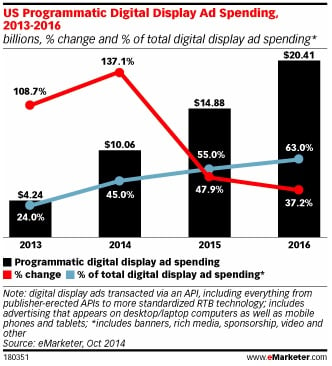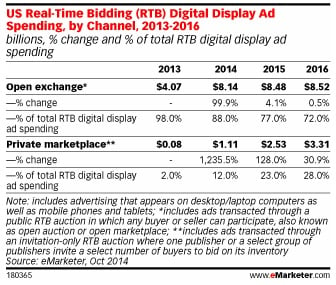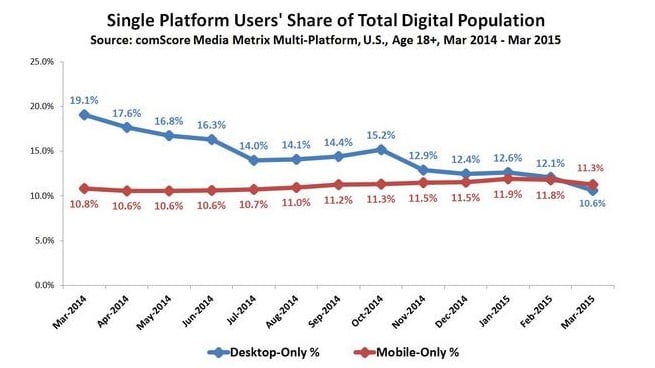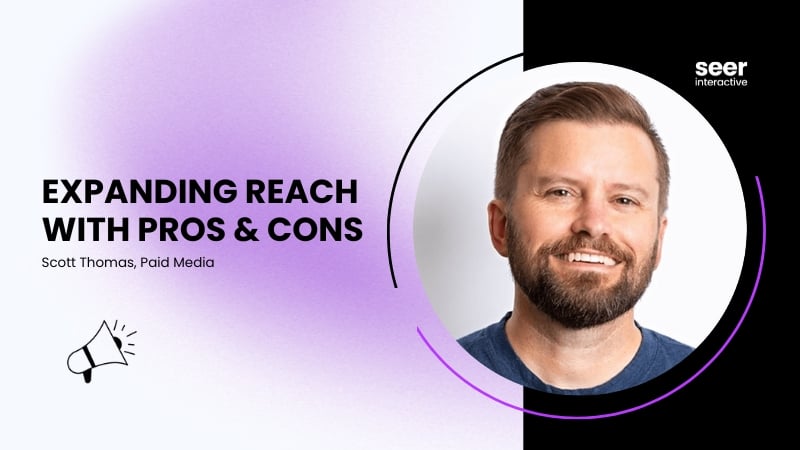This post was originally published in 2015, and last updated April 2021.
Focusing my day-to-day solely on paid search practices is fairly new to me as I have recently started as a PPC Associate here at Seer Interactive. Of course, coming from a full-service agency, I assisted with the PPC campaigns but my background primarily comes from traditional and programmatic advertising.
Programmatic advertising is a large buzzword in the marketing world. Soon, we will see it as a full capability within the mobile ad space. Some companies may offer in-app targeting while other companies only offer within the mobile site.
This idea of how companies grow and evolve to get ahead of their competition and the next trend fascinates me. I want to understand which company is the best and for which vertical would I see the best results. I always strove to build the ultimate campaign; whether it was increasing visibility for a branding initiative or driving leads to push a consumer further down the purchasing funnel.
What is Programmatic Advertising?
If you aren’t familiar with programmatic advertising, the automated process of buying ads online, this post will get you up to speed. There are a million different consumer datasets that companies study to create their own targeting capabilities. Programmatic allows marketers to move away from a broad website-based campaign to a more strategically segmented campaign reaching consumers who are more likely to show interest in the brand. It is the idea that we, as marketers, can reach the right audience at the right time resulting in higher quality leads and conversions.
Nestlé ran a programmatic branding campaign and saw strong results from their efforts. According to Google success stories, Nestlé had the goal to maximize the sale of coffee machines. They optimized based on viewability of ads and brand safety (made possible with Doubleclick reporting capabilities). They also wanted to reach a brand new audience.
Their results showed 91% of their ads delivered to new visitors, 7x improved brand safety and saw 21 points more viewable impressions than the IAB standards.
With technology ever-evolving, marketers can now improve the quality of their campaign in real-time. This is the big draw to programmatic advertising. Due to real-time bidding (RTB), advertisers pay for the consumers they want to reach rather than hoping to reach them, giving you complete control over your campaign.
Think with paid search, a news article comes out that Beyonce just released her new album (yes, I know. She already did this) and you are a local music store selling cd’s… you might want to capitalize on that opportunity. You may start by increasing bids on related terms to beat the competition or by adjusting ad copy to focus on the trending news to be more relevant.
With programmatic, you have the same control.
You can increase rotation more heavily on relevant banner ads, adjust CPM bids to blast more impressions, and hand pick the site placements in which you want to run on during the buzz ultimately creating more awareness of your music store leading to more sales.
As mentioned previously, Programmatic advertising is a top buzzword in today’s media market and there are statistics to show why. eMarketer states that digital display ad spending will reach $20.41 billion, or 63% of US digital display ad spending by 2016.

Mobile has been projected to take up 69.3% of the total programmatic digital display ad spending by 2016. (eMarketer)

How to Get Started with Programmatic Advertising
To ensure you craft the ultimate campaign, it’s important to make a list of the type of campaign you are looking to run. Here are some questions to know before starting the conversation with potential programmatic advertising partners:
- Determine campaign goal
- Branding initiative?
- Lead-based?
- Conversion-based?
- Determine budget
- Since many programmatic advertising partners have a minimum, it’s beneficial to understand if you can meet their minimums dependent upon how many partners you are looking to bring on.
- Set campaign flight dates
- By providing flight dates, you give the sales rep and understanding of how much you are willing to pay across ‘X’ amount of months/weeks.
- Have a CPM in mind that you are willing to pay
- Having a CPM in mind will help with your negotiation tactics, don’t be afraid to negotiate. They are new to the partnership, so are you. Companies want to win your business.
- Determine target audience
- You want to make sure the partner you are vetting has the targeting capabilities and segments to reach your target audience.
- Determine target location
- Location targeting is very important as it may vary the pricing structure for the partner. Make sure you have an idea of how segmented you want your campaign to be.
Now what?
Don’t know what questions to ask? Below are a couple of questions to keep in mind and how why they are important to understand.
- How do you source your inventory?
- Understanding how a partner sources inventory is important to understand what type of inventory you will be receiving. You want to ensure your campaign will achieve the scale needed to drive the best outcome for your campaign.
- What are your targeting capabilities?
- This is an especially important question when you have a client that has a specific target audience. If a partner you are vetting doesn’t have the ability to target age and gender but you specifically want to reach those 40-60-year-old males, then they wouldn’t be the correct partner to drive the best results.
- Do you offer retargeting?
- Retargeting is an important way to drive leads and sales from any type of campaign. If a consumer continues to see your ad over and over, and they already showed interest in your product, you can continue to push them further down the funnel.
- Another idea to keep in mind during the conversation is if the partner has the ability to exclude an already converted consumer. This becomes important with a membership-type sale. If the consumer is already a member, you wouldn’t want to keep serving impressions to them when you could utilizing those impressions towards a brand new audience.
- According to Digital Information World, website visitors who are retargeted by your display ad are 70% more likely to convert. Retargeted display ads also led to a 1046% increase in branded search.
- What verticals do you typically see the best results from?
- I tend to not be candid with the type of client I may want to use the company for. This allows for a more open conversation where the sales rep has to answer this question honestly. Many programmatic advertising companies focus on a specific vertical, which is a good thing to know when bringing on new clients within numerous verticals.
- Do you offer fraud protection, brand safety, and have the ability to ensure ad viewability?
- Brand safety and fraud protection have been a large topic within display media for quite some time now. It’s important to understand if the potential partner has the ability to blacklist certain sites or block certain categories to maintain the safety of your brand.
- You also may not want to pay for a large number of impressions that are not visible to the consumer. Adage states that more than 1/3 of online ad traffic is fraudulent. You want to ensure that the partner you are bringing on-board has the ability to prevent fraudulent traffic, ensure consumer visibility, and offer the best inventory for your brand.
- Do you offer mobile targeting capability?
- According to Comscore, mobile-only internet 18+ users exceeds the number of desktop-only internet users. In March 2015, mobile-only users accounted for 11.3% while desktop saw a 10.6%. This is important to understand the convenience of mobile devices and how you, as an advertiser, can reach your consumer every minute of every day. If a partner doesn’t have the capability to target mobile inventory, then you may want to re-think your strategy (given you have a mobile-friendly site...which you should).

- Do you offer a managed support team or are you self-service platform?
- This is an important question to know if you have a small marketing team. You would want to know if the company has the capability to support you and your client. If you don’t have the capacity to run a self-serve campaign, you may want to reconsider.
- What ad sizes does your system support? Does your system support static, flash, and video ad units?
- Understanding the type of ad unit support that the company's platform offers ensures that you have the ability to run any type of campaign that you develop the assets for in the future.
- Google offers a free tool to see vertical-specific benchmarks for differentiating ad units and formats. This can give you a better idea on what may be beneficial for your display campaign to ensure strong performance.
- What’s your CPM?
- This is an important question to ask or negotiate to ensure your client gets the impression visibility needed to drive the strongest results for the campaign.
- Do you utilize any 3rd party data providers or is your audience based on your own 1st party data?
- This question will give you an idea of how large their data segments may be. It’s important to keep in mind the type of audience you want to reach and if those data segments are available. You also might want to ask how they collect the data. Is it cookie-based data? Do they have offline data?
- With the audience insights that is gathered from programmatic advertising partners, you can then share findings across channels (PPC, email, affiliate) to then target more accurately creating a more holistic marketing campaign.
Although there are many more questions to ask, these starting-point questions will allow you to better understand the company’s capabilities. This will give you an idea of the type of campaigns you can create and how you can integrate across different marketing initiatives.
After you talk with the programmatic advertising companies and choose who to run with for your campaign, you can start the execution of the campaigns. With the correct questions and trusted partners, you can build a campaign to drive the best results for your client's goals.


